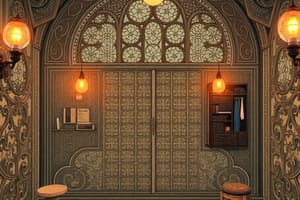Podcast
Questions and Answers
Which of the following materials is a conductor of electricity?
Which of the following materials is a conductor of electricity?
- Metal scissors (correct)
- Glass
- Wood
- Plastic
Electricity can flow in an incomplete circuit.
Electricity can flow in an incomplete circuit.
False (B)
What should you avoid doing with electrical appliances in wet places?
What should you avoid doing with electrical appliances in wet places?
Using them
Electricity is a form of ______.
Electricity is a form of ______.
What is one way to save electricity?
What is one way to save electricity?
Match the following sources of electricity with their descriptions:
Match the following sources of electricity with their descriptions:
It is safe to insert objects into an electrical socket.
It is safe to insert objects into an electrical socket.
What does it mean to 'switch on'?
What does it mean to 'switch on'?
Non-conductors of electricity do not allow electricity to pass through, such as ______ and ______.
Non-conductors of electricity do not allow electricity to pass through, such as ______ and ______.
Which of the following is NOT a safety precaution when using electrical appliances at home?
Which of the following is NOT a safety precaution when using electrical appliances at home?
Electricity can only flow in a complete circuit.
Electricity can only flow in a complete circuit.
Name two examples of conductors of electricity.
Name two examples of conductors of electricity.
To 'switch off' means to ______ a circuit.
To 'switch off' means to ______ a circuit.
Match the following types of electricity sources with their descriptions:
Match the following types of electricity sources with their descriptions:
Which of these is a non-conductor of electricity?
Which of these is a non-conductor of electricity?
Turning off lights when not in use is a way to save electricity.
Turning off lights when not in use is a way to save electricity.
What should you do with electrical appliances in wet places?
What should you do with electrical appliances in wet places?
Electricity is a form of ______.
Electricity is a form of ______.
Flashcards are hidden until you start studying
Study Notes
### Conductors
- Conductors allow electricity to pass through them.
- Examples of conductors include:
- Pins
- Wires
- Metal scissors
- Metal paper clips
- Nails
- Screws
### Non-Conductors
- Non-conductors do not allow electricity to pass through them.
- Examples of non-conductors include:
- Wood
- Plastic
- Glass
- Wool
- Clothes
Using Electricity Safely
- Do not touch electrical appliances with wet hands.
- Do not use electrical appliances in wet places.
- Do not put too many plugs into an electrical socket.
- Do not insert objects into electrical sockets.
- Do not touch broken wires.
Saving Electricity
- Turn off lights when not in use.
- Turn off fans when not in use.
- Turn off computers when not in use.
- Turn off the water heater when not in use.
- Turn off the television when not in use.
Electricity and Circuits
- Electricity is a form of energy.
- Electricity can only flow in a complete circuit.
- To switch on means to close a circuit.
- To switch off means to open a circuit.
Sources of Electricity
- Power stations generate electricity.
- Batteries store electricity.
- Batteries include dry and solar cells.
Conductors of Electricity
- Conductors are materials that allow electricity to pass through them.
- Examples of conductors include: pins, wires, metal scissors, metal paper clips, nails, and screws.
Non-Conductors of Electricity
- Non-conductors are materials that do not allow electricity to pass through them.
- Examples of non-conductors include: wood, plastic, glass, wool, and clothes.
Electrical Safety at Home
- Never touch electrical appliances with wet hands.
- Avoid using electrical appliances in wet places.
- Do not overload electrical sockets with too many plugs.
- Never insert objects into electrical sockets.
- Do not touch broken wires.
Saving Electricity
- Turn off lights when not in use.
- Turn off fans when not in use.
- Turn off computers when not in use.
- Turn off water heaters when not in use.
- Turn off televisions when not in use.
Electricity and Circuits
- Electricity is a form of energy.
- Electricity can only flow in a complete circuit.
- To "switch on" means to close a circuit.
- To "switch off" means to open a circuit.
Sources of Electricity
- Power stations generate electricity.
- Batteries, including dry cells and solar cells, provide electricity.
Studying That Suits You
Use AI to generate personalized quizzes and flashcards to suit your learning preferences.




